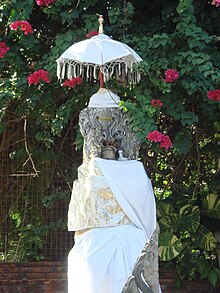Acintya
| Achintya, Tunggal Sanghyang Widhi Wasa | |
|---|---|
 | |
| Affiliation | Supreme God |
| Symbol | empty throne |
Achintya (from
shadow puppet) theatre.[4] All gods, goddesses, and existence are believed to be the manifestation of the Achintya in Balinese Hinduism.[1][5]
Role

Achintya corresponds to a rather recent trend towards monism in Bali, according to which there is one supreme deity, and that all other gods are only manifestations of him.[6][7] Achintya is emptiness and considered as the origin of the Universe, all other divinities emanating from him.[8]
He is often associated with the
sun god,[6] and depicted in human form with flames around him.[6] His nakedness expresses that "his consciousness is no longer carried away by his sense-faculties".[3]
Prayers and offerings are not made directly to Achintya, but also to the other manifestations of the deity.
The introduction of the Padmasana as an altar to the Supreme God, was the result of a 16th-century Hindu reformation movement, led by
Java.[10] Dang Hyang Nirartha built temples in Bali and added the Padmasana shrines to the temples he visited.[11]
When an infant is 210 days old according to the Pawukon calendar in Bali, the Otonan ceremony is first held in order to give thanks to Achintya.
Political aspects

Since the end of
To comply with regulations, Balinese Hindus have felt the need to reinforce the monotheistic component of the faith, thus the more emphasised role of Achintya.[13] To refer to him, they selected the term Sang Hyang Widhi Wasa (glossed as "God Almighty"), which although coined in the 1930s by Protestant missionaries to describe the Christian God, was thought to be well-adapted to describe the Hindu supreme deity.[12] This is thus the name which is now more commonly used by modern Balinese.[6]See also
- Adi-Buddha
- Bhagavan
- Brahman
- Hinduism in Indonesia
- Hyang
- Ishvara
- Shen (Chinese religion)
- Tathāgata
- Tengri
References
- ^ ISBN 978-0-226-88580-3.
- ISBN 978-90-04-31583-9.
- ^ ISBN 9781571814814.
- ^ ISBN 9780710301086.
- ^ "Acintya dalam Perspektif Hindu: Sifat Tak Terpikirkan Tuhan yang Terwujud" (in Indonesian). Pubvel. Archived from the original on 27 December 2023. Retrieved 5 January 2024.
- ^ ISBN 9789814260268.
- ISBN 9781858289021.
- ISBN 9780226885827.
- ISBN 978-1743213896.
- ISBN 978-1743213896.
- ISBN 0-945971-03-6.
- ^ ISBN 0-945971-03-6.
